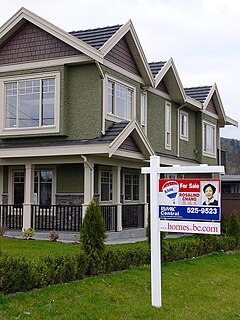Related Research Articles
In finance, discounted cash flow (DCF) analysis is a method of valuing a project, company, or asset using the concepts of the time value of money. Discounted cash flow analysis is widely used in investment finance, real estate development, corporate financial management and patent valuation. It was used in industry as early as the 1700s or 1800s, widely discussed in financial economics in the 1960s, and became widely used in U.S. courts in the 1980s and 1990s.

Renting, also known as hiring or letting, is an agreement where a payment is made for the temporary use of a good, service or property owned by another. A gross lease is when the tenant pays a flat rental amount and the landlord pays for all property charges regularly incurred by the ownership. An example of renting is equipment rental. Renting can be an example of the sharing economy.
A property tax or millage rate is an ad valorem tax on the value of a property, usually levied on real estate. The tax is levied by the governing authority of the jurisdiction in which the property is located. This can be a national government, a federated state, a county or geographical region or a municipality. Multiple jurisdictions may tax the same property.

In finance, the yield on a security is the amount of cash that returns to the owners of the security, in the form of interest or dividends received from it. Normally, it does not include the price variations, distinguishing it from the total return. Yield applies to various stated rates of return on stocks, fixed income instruments, and some other investment type insurance products.
Negative gearing is a form of financial leverage whereby an investor borrows money to acquire an income-producing investment and the gross income generated by the investment is less than the cost of owning and managing the investment, including depreciation and interest charged on the loan. The investor may enter into a negatively geared investment expecting tax benefits or the capital gain on the investment after it is sold to exceed the accumulated losses of holding the investment. The investor would take into account the tax treatment of negative gearing, which may generate additional benefits to the investor in the form of tax benefits if the loss on a negatively geared investment is tax-deductible against the investor's other taxable income and if the capital gain on the sale is given a favourable tax treatment.

Real estate economics is the application of economic techniques to real estate markets. It tries to describe, explain, and predict patterns of prices, supply, and demand. The closely related field of housing economics is narrower in scope, concentrating on residential real estate markets, while the research on real estate trends focuses on the business and structural changes affecting the industry. Both draw on partial equilibrium analysis, urban economics, spatial economics, basic and extensive research, surveys, and finance.
A real estate bubble or property bubble is a type of economic bubble that occurs periodically in local or global real estate markets, and typically follow a land boom. A land boom is the rapid increase in the market price of real property such as housing until they reach unsustainable levels and then decline. This period, during the run up to the crash, is also known as froth. The questions of whether real estate bubbles can be identified and prevented, and whether they have broader macroeconomic significance, are answered differently by schools of economic thought, as detailed below.
Buy-to-let is a British phrase referring to the purchase of a property specifically to let out, that is to rent it out. A buy-to-let mortgage is a mortgage loan specifically designed for this purpose. Buy-to-let properties are usually residential but the term also encompasses student property investments and hotel room investments.
Operating surplus is an accounting concept used in national accounts statistics and in corporate and government accounts. It is the balancing item of the Generation of Income Account in the UNSNA. It may be used in macro-economics as a proxy for total pre-tax profit income, although entrepreneurial income may provide a better measure of business profits. According to the 2008 SNA, it is the measure of the surplus accruing from production before deducting property income, e.g., land rent and interest.
Capitalization rate is a real estate valuation measure used to compare different real estate investments. Although there are many variations, a cap rate is often calculated as the ratio between the net operating income produced by an asset and the original capital cost or alternatively its current market value.
Real estate investing involves the purchase, ownership, management, rental and/or sale of real estate for profit. Improvement of realty property as part of a real estate investment strategy is generally considered to be a sub-specialty of real estate investing called real estate development. Real estate is an asset form with limited liquidity relative to other investments, it is also capital intensive and is highly cash flow dependent. If these factors are not well understood and managed by the investor, real estate becomes a risky investment.
Leaseback, short for "sale-and-leaseback", is a financial transaction in which one sells an asset and leases it back for the long term; therefore, one continues to be able to use the asset but no longer owns it. The transaction is generally done for fixed assets, notably real estate, as well as for durable and capital goods such as airplanes and trains. The concept can also be applied by national governments to territorial assets; prior to the Falklands War, the government of the United Kingdom proposed a leaseback arrangement whereby the Falklands Islands would be transferred to Argentina, with a 99-year leaseback period, and a similar arrangement, also for 99 years, had been in place prior to the handover of Hong Kong to mainland China. Leaseback arrangements are usually employed because they confer financing, accounting or taxation benefits.
An Australian real estate investment trust (A-REIT) is a unitised portfolio of property assets, listed on a stock exchange, usually the Australian Securities Exchange (ASX). Such investment structures were known as listed property trusts (LPT) in Australia until February 2008, but were renamed to be more consistent with international terms. Unit trusts of property assets which are not listed on a stock exchange are known as unlisted property trusts.
The income approach is one of three major groups of methodologies, called valuation approaches, used by appraisers. It is particularly common in commercial real estate appraisal and in business appraisal. The fundamental math is similar to the methods used for financial valuation, securities analysis, or bond pricing. However, there are some significant and important modifications when used in real estate or business valuation.
The German income approach is the standard approach used in Germany for the valuing of property that produces a stream of future cash flows.
Return on investment (ROI) is a ratio between net profit and cost of investment. A high ROI means the investment's gains compare favorably to its cost. As a performance measure, ROI is used to evaluate the efficiency of an investment or to compare the efficiencies of several different investments. In economic terms, it is one way of relating profits to capital invested.
An investment rating of a real estate property measures the property’s risk-adjusted returns, relative to a completely risk-free asset. Mathematically, a property’s investment rating is the return a risk-free asset would have to yield to be termed as good an investment as the property whose rating is being calculated. The underlying drivers for property ratings are the dividends and capital gains over a certain holding period, and their associated risks or variances. Similar to other financial ratings developed for mutual funds and stocks, it can be assumed that investors have constant relative risk aversion over the wealth derived from other sources and from their investments. For simplicity, it can also be assumed that the investment return is not correlated with other sources of wealth but represents 100% of the investor's wealth. A property’s investment rating is then a transformation of the risk-adjusted averaged return to a single number that conveys the property’s long-term potential to yield profits.
Real estate benchmarking is the standard of measurement used to analyze the financial characteristics of a real estate investment property. In the general sense, real estate benchmarking refers to the comparison of potential real estate investment properties against a predetermined framework of measurement. In a narrow sense, the term real estate benchmarking refers to the specific real estate indicators used to measure the real estate properties.
Property investment calculator is a term used to define an application that provides fundamental financial analysis underpinning the purchase, ownership, management, rental and/or sale of real estate for profit. Property Investment Calculators are typically driven by mathematical finance models and converted into source code. Key concepts that drive property investment calculators include returns, cash flow, affordability of financing, investment strategy, equity and risk management.
In United States real estate business, normally the landlord, rather than the tenant, is responsible for real estate taxes, maintenance, and insurance. In a, "net lease" the tenant or lessee is responsible for paying, in addition to base rent, some or all of the recoverable expenses related to real-estate ownership. As the rent collected under a net lease is net of expenses, the base rent tends to be lower than rent charged under a gross lease.
References
- ↑ "Understanding the Gross Rent Multiplier in Commercial Real Estate". Propertymetrics.com. Retrieved 2016-09-13.
- ↑ "Small Residential Income Property Appraisal Report" (PDF). Fanniemae.com. Retrieved 2 April 2019.
- ↑ "Market Value of Investment Real estate". apartmentpropertyvaluation.com. Retrieved 15 September 2019.
| This real estate article is a stub. You can help Wikipedia by expanding it. |